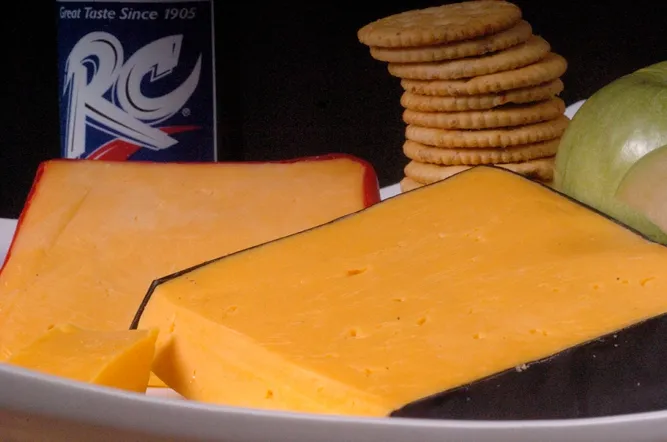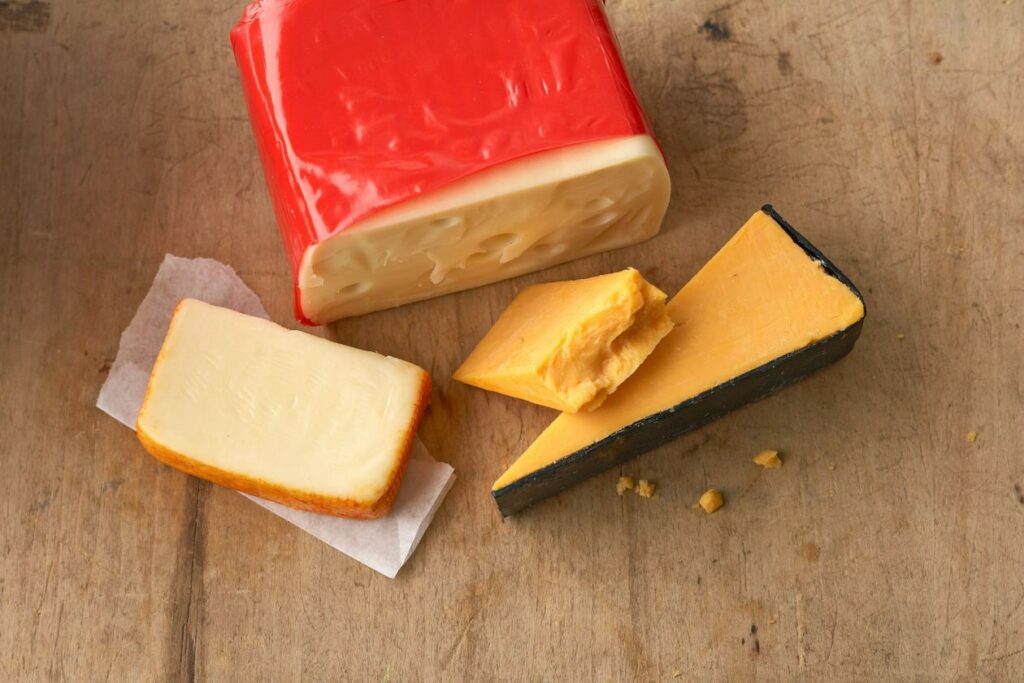What is Hoop Cheese? The Traditional Delight from Southern United State

If you’ve found your way to this post, chances are you’ve heard about a southern gem known as Hoop Cheese and want to learn more. Well, you’re in for a treat!
This humble, yet delightfully versatile cheese has been a staple in southern kitchens for generations, but it remains relatively unknown outside of its traditional territory.
In this guide, we’re going to peel back the waxed rind and delve deep into the world of Hoop Cheese.
We’ll explore its rich history, how it’s made, where you can find it, and most importantly, how you can enjoy it to its fullest.
Quick Facts About Hoop Cheese
| Hoop Cheese Quick Facts | Description |
|---|---|
| Origin | United States, particularly in the South |
| Milk Source | Traditionally made from cow’s milk |
| Texture | Semi-hard to hard, depending on the aging process |
| Flavor | Mild and slightly tangy, with a creamy texture |
| Color | Pale yellow |
| Aging Process | Usually fresh with little to no aging, but can be aged for a stronger flavor |
| Historical Origins | Has its roots in the Southern United States, and was traditionally made by small farmers |
| Uses | Often used as a snack cheese or in cooking. It can be sliced, fried, or melted |
What kind of cheese is hoop cheese?

Hoop cheese is a traditional cow’s milk cheese, known for its simplicity and unique characteristics. It’s often described as mild and slightly salty with a rubbery texture when young, which transforms into a sharp and crumbly consistency if allowed to age.
Its color can vary, but it generally has a rich hue. This cheese is made directly from milk, with the whey completely pressed out, distinguishing it from some other types of cheese. Hoop cheese is common in the Southern United States and continues to be available today.
Some variants are also known as “queso blanco,” a firm, dry cheese that is white in color.
What is another name for hoop cheese?
Another common name for hoop cheese is “red ring cheese.”
This name comes from the traditional red wax coating often found on the exterior of the cheese, which gives it a distinctive appearance.
It’s worth noting that in some regions, particularly in Latin American countries, hoop cheese may also be referred to as “queso de bola,” meaning “ball cheese” due to its round shape.
What is special about hoop cheese?
Hoop cheese has several unique features that set it apart:
- Shape and Appearance: As the name suggests, hoop cheese is typically formed into a round or “hoop” shape, which gives it a distinctive look compared to other cheeses. Some variants are coated in red wax, leading to its alternative name, “red ring cheese.”
- Preparation Method: Hoop cheese is made from cow’s milk and is unique in that the whey is completely pressed out during the cheese-making process. This creates a dense, rich cheese with a texture that varies from soft and rubbery when young, to hard and crumbly when aged.
- Flavor Profile: Hoop cheese has a mild, slightly salty flavor that can become sharper as the cheese ages. Its simple, unadulterated taste makes it versatile for various culinary uses.
- Cultural Significance: Hoop cheese is a traditional Southern United States cheese, often found in country stores and farmers markets. It holds a special place in southern food culture and tradition.
Is hoop cheese the same as cheddar?
No, hoop cheese and cheddar cheese are not the same. While both are made from cow’s milk, they differ in their production process and resulting flavor and texture.
| Attribute | Hoop Cheese | Cheddar Cheese |
|---|---|---|
| Origin | Southern United States | England |
| Milk Source | Cow’s milk | Cow’s milk |
| Texture | Soft and rubbery when young, hard and crumbly when aged | Smooth and firm, becoming more crumbly with age |
| Flavor | Mild, slightly salty | Ranges from mild to extra sharp depending on aging |
| Color | Typically yellow or cream-colored | Can range from white to deep orange |
| Aging Process | Not typically aged for long periods | Can be aged for several months to many years |
| Unique Features | Formed into round shapes (“hoops”) | Undergoes a unique “cheddaring” process |
| Use in Cooking | Versatile due to its mild flavor | Used in a wide variety of dishes due to its distinct flavor |
Hoop Cheese:

This is a simple, traditional cheese where the whey is completely pressed out. It has a mild, slightly salty flavor and a texture that ranges from soft and rubbery when young to hard and crumbly when aged. Hoop cheese is often formed into round shapes, hence its name.
Cheddar Cheese:

Cheddar is a widely popular cheese known for its distinct flavor which can range from mild to extra sharp depending on how long it’s aged. During its production process, cheddar undergoes a unique step called “cheddaring” where the curds are cut, stacked, and turned repeatedly – a step not used in the making of hoop cheese. The texture of cheddar is generally smooth and firm, but it becomes more crumbly with age.
>> Click here to read our in-depth guide on Cheddar
Do they still make hoop cheese?
Yes, hoop cheese is still being produced today. It was a common staple in the Southern United States from the early to mid-1900s and continues to be available in the present day.
It’s not only found in traditional grocery stores but also available for purchase online. Some cheese makers, like Ashe County Cheese and Stripling’s, offer varieties of hoop cheese, including the traditional white and the red rind versions.
Other sources like Black’s Peaches in York, SC, even locally source their hoop cheese, ensuring super fresh products for their customers.
Sites where you can purchase hoop cheese online:
- Stripling’s – They offer an Old Fashioned Red Rind Hoop Cheese, which is mild in taste and great when served as a dessert cheese.
- William’s Cheese – They sell a mild, slightly salty Hoop cheese with a rubbery texture when young.
- Salt Lick Sausage – They offer hoop cheese by the pound, available in either black rind or red rind.
- Mars Cheese Castle – They sell Genuine Hoop Cheese, hand-cut for every order.
- Walmart – They offer Wisconsin Farms Red Hoop cheddar cheese, a rich source of calcium with a mild flavor.
What is the closest cheese to hoop cheese? Top 7 substitutes
The closest substitutes to hoop cheese vary based on the texture and flavor you’re seeking. Some of the most common substitutes include:
- Cottage Cheese: This is a fresh cheese curd product with a mild flavor.
- Farmer’s Cheese: This is a mildly flavored, unripened cheese made by adding bacterial starter and rennet to cow’s milk.
- Tofu: While not a cheese, tofu can mimic the texture of hoop cheese in some recipes, especially if you’re seeking a dairy-free option.
- Pot Cheese: A type of soft, farmer-style cheese, similar to cottage cheese but drained longer and thus is drier.
- Ricotta Cheese: It’s an Italian whey cheese made from sheep, cow, goat, or Italian water buffalo milk whey left over from the production of other cheeses.
- Paneer: A fresh, unsalted cheese common in Indian cuisine.
- Cheddar Cheese: Can be used as a substitute for hoop cheese in many recipes due to its firm texture and sharp flavor.
Is hoop cheese mild or sharp? Tasting notes
Hoop cheese is typically mild and slightly salty with a rubbery texture when it’s young. However, if allowed to age, it can become sharper in flavor and crumbly in texture.
Some variations of hoop cheese, like the Stripling’s Old Fashioned Black Rind Hoop Cheese, are specifically made to be sharper and more acidic in taste.
Hoop cheese is often likened to a mild cheddar in flavor, but unlike cheddar, it’s formed into rounds, hence the name “hoop”. Its taste is neutral enough that it pairs well with other flavorful cheeses like sharp cheddar.
Also read: 12 Most Popular Cheeses in the World
How do you eat hoop cheese?
Hoop cheese can be enjoyed in various ways due to its versatile and mild flavor:
- As a Snack: Slice it and enjoy it on its own or with crackers, fresh fruits, or pickles.
- In Sandwiches: Hoop cheese can be sliced and used in sandwiches, providing a mild, creamy element.
- Melted: It melts well, so you can use it in grilled cheese sandwiches, quesadillas, or macaroni and cheese.
- Baked Goods: It can also be grated and used in baked goods like biscuits or cornbread.
- With Wine: It pairs well with wine, especially lighter white wines or fruity reds.
- Cheese Board: Include hoop cheese on a cheese board with a variety of other cheeses, fruits, nuts, and bread for a delicious appetizer or snack.
- Breakfast: It’s often served with country ham and biscuits in the Southern United States.
Also read: The Perfect Cheese Board: Top 10 Cheeses You Must Include
Is hoop cheese healthy?
Hoop cheese can be a part of a healthy diet when consumed in moderation. Here are some of the health benefits and considerations:
Benefits:
- Protein: Hoop cheese is rich in protein, which is essential for building and repairing tissues in the body.
- Calcium: It’s also a good source of calcium, which is necessary for bone health.
- Phosphorus and Potassium: Hoop cheese contains phosphorus and potassium, important minerals for various bodily functions.
Considerations:
- Saturated Fat: Hoop cheese is high in saturated fat. While fats are an important part of a balanced diet, consuming too much saturated fat can raise your levels of “bad” LDL cholesterol and increase your risk of heart disease.
- Sodium: It’s also high in sodium, which can lead to high blood pressure if consumed in excess.
- Calories: Cheese can be calorie-dense, so portion control is important to avoid unnecessary weight gain.
What are the ingredients in Hoop Cheese?
- Cow’s milk: This is the primary ingredient used to make hoop cheese.
- Curds: The curds are separated from the whey in the milk through a process called curdling. The curds are what give cheese its solid form.
- Salt: Although some versions of hoop cheese do not contain salt, it is often used to enhance the flavor of the cheese and act as a preservative.
- Cream: Some hoop cheese recipes may include cream for a richer flavor and texture.
Note: The exact ingredients can vary depending on the specific recipe or brand of hoop cheese.
Hoop cheese nutrition facts
| Nutritional Component | Quantity (per serving) |
|---|---|
| Calories | 110 |
| Fat | 9g |
| Protein | 7g |
| Carbohydrates | 1g |
| Sodium | Approx. 643mg |
Also read: Savor the Flavor: 20 Cheeses with the Least Lactose
Is hoop cheese pasteurized?
Yes, hoop cheese is typically made with pasteurized milk. Pasteurization is a process of heating milk to a specific temperature to kill harmful bacteria, ensuring the cheese is safe for consumption.
What is the difference between red rind and black rind hoop cheese?
Hoop cheese, a traditional Southern United States food product, is often differentiated by the color of the rind. The two most common types are red rind and black rind hoop cheese.
The main difference between the two lies primarily in their aging process and flavor profile:
| Red Rind Hoop Cheese | Black Rind Hoop Cheese | |
|---|---|---|
| Ageing | Typically younger and less aged | More aged |
| Flavor | Mild, creamy flavor | Stronger, sharper flavor due to longer aging process |
| Texture | Softer in texture | Harder texture due to longer aging process |
| Moisture Content | Higher moisture content because it’s less aged | Lower moisture content because it’s more aged |
Both types of cheese are made using similar ingredients – mainly milk, curds, and sometimes salt. The color of the rind does not affect the nutritional value of the cheese; it’s more about the flavor and texture preferences of the individual consuming it.
Please note that the practices can vary depending on the specific cheese maker or brand. Always check the product label for the most accurate information.
The history of hoop cheese
Hoop cheese, also known as Bakers or Red Ring cheese, is a simple and traditional type of cheese made from cow’s milk where the whey has been completely drained out. The name “hoop” refers to the round mold used to shape the cheese during its production process.
The history of hoop cheese dates back to the 19th century. It was originally created by accident when a cheesemaker forgot about a batch of cheese curds and found that they had formed into a solid, yet soft cheese. This discovery led to the creation of what we now know as hoop cheese.
Hoop cheese was commonly produced in the Southern United States from the early to mid-1900s. In particular, it was mass-produced in Otsego County, New York, during the 1910s and shipped with farmer cheese. The cheese also has a history in the Blue Ridge Mountains, where cheese production began in the 1930s when the Kraft Corporation built a plant in West Jefferson.
Despite changes in cheese production and consumption over the years, hoop cheese is still available today and continues to be enjoyed for its mild flavor and versatile uses.
Frequently Asked Questions
1. Why is hoop cheese not refrigerated?
Hoop cheese has a unique characteristic that sets it apart from many other cheeses – it’s often found unrefrigerated. The reason for this lies in its traditional manufacturing process and composition.
Hoop cheese is made by pressing curd until almost all the whey is expelled, resulting in a low moisture content. This low moisture content, coupled with the cheese’s high salt content, creates a naturally preserved product that is less susceptible to spoilage.
Therefore, it can be safely stored at room temperature for a certain period.
However, once cut into, it is advisable to refrigerate hoop cheese to maintain its freshness and prevent it from drying out.
2. Can hoop cheese be frozen?
Yes, hoop cheese can be frozen for preservation purposes. To achieve the best results, it is advisable to freeze the cheese for no more than six months.
When preparing the cheese for freezing, it should be cut into portions no larger than a half-pound each, and then wrapped tightly. This helps maintain the quality of the cheese during the freezing process.
However, it’s important to note that while freezing doesn’t pose any health risks, it may alter the texture and flavor of the cheese.
Therefore, when using frozen cheese, it’s generally better suited for cooked dishes rather than fresh consumption.
Lastly, once defrosted, hoop cheese should be stored in the refrigerator at 40 degrees Fahrenheit or below to prevent spoilage.
3. How long can hoop cheese sit out?
Hoop cheese, due to its low moisture and high salt content, can sit out at room temperature for a longer duration compared to many other cheese varieties. However, it’s still recommended to limit this time to about two hours for optimum quality and food safety.
After this period, the chance of bacterial growth increases, which could potentially lead to foodborne illness.
Once you’ve cut into the hoop cheese, it’s best to refrigerate it to maintain its freshness and extend its shelf life. Remember, in terms of food safety, it’s always better to err on the side of caution.
4. How do you store hoop cheese?
Storing hoop cheese properly is essential to maintain its quality and extend its freshness. Ideally, hoop cheese should be refrigerated at a temperature of 35-40°F (1.6-4.4°C).
It should be wrapped tightly in wax paper or cheese paper, which allows the cheese to breathe while preventing it from drying out.
If these are not available, plastic wrap can be used as an alternative, but make sure it’s sealed well to prevent air exposure.
Storing hoop cheese in a special cheese drawer or a separate compartment in your refrigerator can also help to keep it fresh.
For long-term storage, consider vacuum sealing the cheese and then freezing it, although this may alter the texture slightly.
Also read: What’s the Best Way to Store Cheese?
5. Why is hoop cheese orange?
The characteristic orange color of hoop cheese, and many other cheeses, is a result of the addition of a natural dye called annatto.
Annatto is derived from the seeds of the achiote tree and has been used for centuries to impart a rich yellow-orange color to foods.
The use of annatto in cheese-making began as a way to mimic the deep yellow color that milk takes on when cows have been eating fresh, beta-carotene-rich grass.
Over time, this practice evolved into a tradition, and the orange hue became associated with certain types of cheese, like hoop cheese.
However, the color doesn’t influence the flavor of the cheese—it’s purely aesthetic.
6. Do you eat the coating on hoop cheese?
The rind coating is generally non-toxic and safe to consume. However, it doesn’t offer much in terms of flavor and can have a waxy texture.
Therefore, most people prefer to remove the rind before eating hoop cheese. It’s always a good idea to cut away the outer layer to fully enjoy the rich, creamy taste of the cheese itself.
Also read:
- Discovering Panela: A Guide to Mexico’s Versatile Cheese
- Pecorino Romano: The Ultimate Guide to Italy’s Age-Old Cheese
- Utz Cheese Balls: The Ultimate Guide (Taste the Tradition)
- A Guide to Havarti: The Star Cheese of the Culinary World
- The Ultimate Guide to Gruyère: A Swiss Delicacy
- Cheese Curds: The Unsung Heroes of the Dairy World
- Fior di Latte: A Comprehensive Guide to Italy’s Creamy Delight





